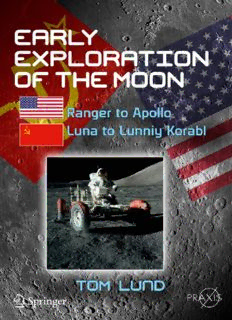
Early Exploration of the Moon: Ranger to Apollo, Luna to Lunniy Korabl PDF
Preview Early Exploration of the Moon: Ranger to Apollo, Luna to Lunniy Korabl
Springer Praxis Books Space Exploration More information about this series at http://www.springer.com/series/4097 Tom Lund Early Exploration of the Moon Ranger to Apollo, Luna to Lunniy Korabl Tom Lund San Diego, CA, USA Springer Praxis Books Space Exploration ISBN 978-3-030-02070-5 e-ISBN 978-3-030-02071-2 https://doi.org/10.1007/978-3-030-02071-2 Library of Congress Control Number: 2018959133 © Springer Nature Switzerland AG 2018 This work is subject to copyright. All rights are reserved by the Publisher, whether the whole or part of the material is concerned, specifically the rights of translation, reprinting, reuse of illustrations, recitation, broadcasting, reproduction on microfilms or in any other physical way, and transmission or information storage and retrieval, electronic adaptation, computer software, or by similar or dissimilar methodology now known or hereafter developed. The use of general descriptive names, registered names, trademarks, service marks, etc. in this publication does not imply, even in the absence of a specific statement, that such names are exempt from the relevant protective laws and regulations and therefore free for general use. The publisher, the authors, and the editors are safe to assume that the advice and information in this book are believed to be true and accurate at the date of publication. Neither the publisher nor the authors or the editors give a warranty, express or implied, with respect to the material contained herein or for any errors or omissions that may have been made. The publisher remains neutral with regard to jurisdictional claims in published maps and institutional affiliations. Cover design: Jim Wilkie. Image credit: NASA Project Editor: David M. Harland This Springer imprint is published by the registered company Springer Nature Switzerland AG Switzerland AG The registered company address is: Gewerbestrasse 11, 6330 Cham, Switzerland This book is dedicated to my wife Barbara and to my children Ann, Tom, and Colin. Introduction The machines known as spacecraft that enabled early exploration of the moon were ingenious and reflected the best efforts of talented people working with the technology of the day. Those moon-bound spacecraft, designed in the 1960s, were remarkable for their performance, efficiency, and ruggedness. It is instructive to examine these machines and see just how capable they were and how best performance was wrung out of the technology available. This book covers early lunar exploration efforts by the United States and by the Soviet Union. Russia was the major entity of the Soviet Union at the time, and the development of spacecraft was a Russian endeavor. Early exploration of the moon by the United States involved the Ranger, Lunar Orbiter, Surveyor, and Apollo spacecraft. The exploration advanced from taking photographs as the Ranger hurdled to impact the moon to the impressive manned lunar landing and exploration missions of Apollo. Russian spacecraft that explored the moon included lunar impactors, lunar flyby spacecraft, lunar landers, lunar orbiters, lunar sample return spacecraft, and the capable Lunokhod lunar rovers. The first five of those spacecraft were simply given the name Luna followed by a number. Russian hardware for a manned lunar landing did not rise to the task. The author had significant responsibility for landing radars for both the Surveyor and Apollo programs. As a result, he had keen interest in all of the space programs during those pioneering years. Writing this book provided opportunity to relive some of those heady times and a chance to use material from his files. The early space programs took place at a time when there were impressive aeronautical programs in the United States. The SR-71 Blackbird was cruising at Mach 3.2 at 80,000 feet with its crew of two for over 3,000 miles without breaking a sweat, and the X-15 was rocketing along at Mach 6.7 and reaching altitudes of 354,000 feet. The challenges of the difficult Apollo program did not seem insurmountable in that era. The pinnacle of lunar exploration was the mission of Apollo 17 that saw the exploration of the moon by a trained geologist, Harrison Schmitt. Schmitt and Gene Cernan, commander of the mission, traveled 21 miles around the surface of the moon in a dune buggy-type vehicle, stopping frequently to explore. A striking photograph of Dr. Schmitt examining a large boulder on the surface of the moon is shown below (Fig. 1 ). Fig. 1 Geologist Harrison Schmitt examining a boulder on the lunar surface (NASA photograph) Early US hardware built for lunar exploration was dimensioned in English units. The author stuck with that treatment of units for US hardware in this book. An exception is the US Lunar Orbiter that used metric units, and that convention was retained. Russian hardware was dimensioned in metric units, and that convention was retained as well. Contents 1 The Nature of the Moon 2 The Ranger Lunar Photography Mission Early US Ventures into Space Early History of NASA Overview of the Ranger Project Launch of Ranger Spacecraft and Flight to the Moon Deep Space Tracking Network Configuration of Ranger Spacecraft Block III Ranger Flight of the Rangers Flight of Ranger 6 Flight of Ranger 7 Flight of Ranger 8 Flight of Ranger 9 3 The Lunar Orbiter Photography Mission Background of the Lunar Orbiter Program Overview of Lunar Orbiter Program Launch and Insertion into Lunar Orbit Details of Lunar Orbiter Photographic Subsystem Communications Subsystem Power Subsystem Velocity Control Subsystem Attitude Control Subsystem Flight of the Lunar Orbiters Flight of Lunar Orbiter 1
